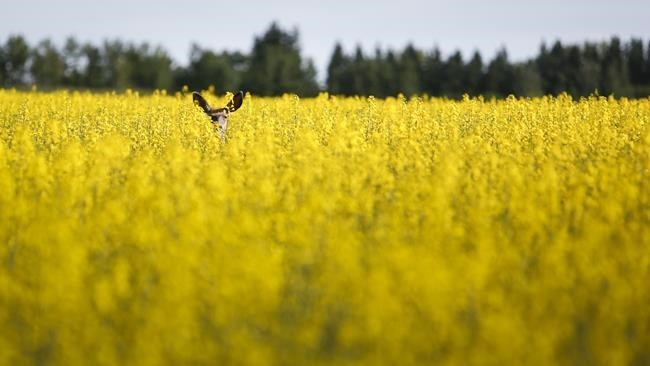CALGARY — A new industry-led report suggests Canada's farmers can likely only achieve half of the federal government's targeted 30 per cent reduction in fertilizer emissions by 2030.
The report, commissioned by Fertilizer Canada and the Canola Council of Canada, examines what effect a 30 per cent reduction in greenhouse gas emissions from the use of nitrogen-based fertilizers on Canadian farms would have on crop yields and farm financial viability.
The report concludes that it may be possible to achieve a 14 per cent reduction in emissions from fertilizer by 2030, but that reaching 30 per cent is not "realistically achievable without imposing significant costs on Canada’s crop producers and potentially damaging the financial health of Canada’s crop production sector."
“I believe what (this report) is saying is the 30 per cent reduction target is not achievable without putting production and exports in jeopardy, and we’ve been saying that all along," said Tom Steve, general manager of the Alberta Wheat and Barley Commissions.
"It was an arbitrary target that was set somewhere in the government, with no path as to how it was going to be achieved."
Ottawa first established its 30 per cent target for fertilizer emissions reduction in late 2020, as part of the federal government's overall climate change plan, and recently wrapped up a months-long consultation process on it.
According to the government, between 2005 and 2019, fertilizer use on Canadian farms increased by 71 per cent. Over the same period, fertilizer-related emissions of nitrous oxide (a greenhouse gas 365 times more potent, from a global warming perspective, than carbon dioxide) in Canada increased by 54 per cent. In 2019 alone, according to the government, the application of nitrogen-based fertilizer resulted in 12.75 million tonnes of greenhouse gas emissions — the equivalent to that produced by 3.9 million passenger vehicles.
The government has said its 30 per cent target is a goal, not a mandatory enforceable target. It has also said it believes the target is achievable, since many of the required technologies and practices to reduce emissions from fertilizer use already exist.
Still, farmers have warned the goal is too ambitious, especially at a time when Canada's agriculture industry is being asked to produce more to help address global food security fears.
"It's really taken our eye off the ball of what is needed in our industry, which is to become more efficient and productive and competitive," Steve said. "Most farmers already do whatever they can to reduce their use of fertilizer — it's their most expensive input."
Karen Proud, president and chief executive of Fertilizer Canada, said there are already a number of industry-accepted best practices in place when it comes to fertilizer management. These include using the right fertilizer for the soil, as well as applying it at the right time of year and in the right amounts.
By helping more farmers become aware of these practices and encouraging them to adopt them, Proud said, the industry could potentially achieve a 14 per cent reduction in emissions by 2030. While that's an aggressive target, she said, it would strike a balance between the needs of the environment and the need for continued increased food production going forward.
Proud said that going beyond a 14 per cent reduction by 2030 would be economically unviable, since many of the changes required — such as working with a certified crop adviser, or doing soil testing — are costly for the farmer.
"We need to be able to allow farmers to increase their productivity to offset the costs of implementing these best practices," she said. "The only way to do that is you allow them to increase yields, or the math doesn't work. You can't ask farmers to invest in practices at a loss."
In February of this year, the federal government announced funding of up to $182.7 million for 12 recipient organizations to deliver the On-Farm Climate Action Fund across Canada. Through the fund, Canadian farmers will be eligible to receive direct support for environmental best practices, including nitrogen fertilizer management, soil sampling and analysis, and equipment modifications for fertilizer application in fields.
Canada has set the goal of achieving net-zero greenhouse gas emissions by 2050. According to the federal government, the agriculture sector has generated approximately 10 per cent of Canada's total greenhouse gas emissions annually since 1990.
In an emailed statement, federal Agriculture Minister Marie-Claude Bibeau said she welcomes the industry report, adding it's good news in that it proves how much can be achieved using technologies and practices that already exist.
"We encourage fertilizer companies to keep developing new forms of fertilizers that emit less GHG into the atmosphere," Bibeau said, adding agricultural producers are the first to be affected by climate change and are strongly committed to reducing their environmental impact.
"We will continue to work with the agriculture sector and other partners to find ways to optimize nutrient management on the farm and establish a path forward to meeting this target.”
This report by The Canadian Press was first published Sept. 7, 2022.
Amanda Stephenson, The Canadian Press




